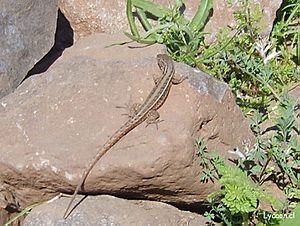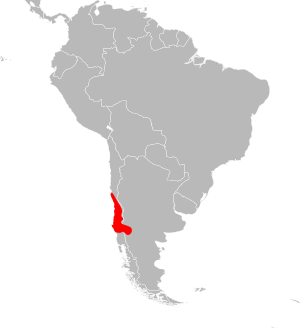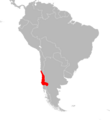Wreath tree iguana facts for kids
Quick facts for kids Wreath tree iguana |
|
|---|---|
 |
|
| Conservation status | |
| Scientific classification | |
| Genus: |
Liolaemus
|
| Species: |
lemniscatus
|
 |
|
The Liolaemus lemniscatus, also known as the wreath tree iguana or elegant tree iguana, is a fascinating type of lizard. It belongs to the Iguanidae family, which includes many different kinds of iguanas. These small, active lizards are native to South America.
You can find the wreath tree iguana living in two countries: Argentina and Chile. They prefer specific environments in these regions. Scientists first described this species in 1837, giving it its scientific name.
Contents
What is a Wreath Tree Iguana?
The wreath tree iguana is a small to medium-sized lizard. It has a slender body and a long tail. Its skin often shows beautiful patterns and colors. These colors help it blend into its surroundings. This is a great way to hide from predators!
Where Do Wreath Tree Iguanas Live?
These iguanas are found in parts of Argentina and Chile. They typically live in areas with lots of trees and shrubs. This is why they are called "tree iguanas." They are very good at climbing and moving through branches. Their habitat often includes forests, woodlands, and even some rocky areas.
Climate and Habitat
The climate where they live can vary. It might be temperate or have distinct seasons. They adapt well to different temperatures. Their homes are usually places where they can find plenty of insects to eat. They also need sunny spots for basking. Basking means lying in the sun to warm up their bodies.
What Do Wreath Tree Iguanas Eat?
Wreath tree iguanas are mostly insectivores. This means their main diet consists of insects. They are skilled hunters, using their quick movements to catch prey.
Favorite Foods
Their diet includes a variety of small creatures. They love to eat crickets, grasshoppers, and beetles. Sometimes, they might also eat other small invertebrates. They use their sharp eyesight to spot tiny insects moving on leaves or branches.
How They Hunt
These lizards are very active during the day. They spend their time searching for food. They often wait patiently for an insect to come close. Then, they quickly dart out to catch it. Their speed and agility make them excellent hunters in their natural environment.
Life Cycle and Reproduction
The life cycle of the wreath tree iguana involves several stages. Like most reptiles, they reproduce by laying eggs. This process ensures the continuation of their species.
Mating and Egg Laying
Female wreath tree iguanas lay their eggs in safe places. These spots are usually hidden underground or under rocks. This protects the eggs from predators and harsh weather. The number of eggs can vary, but it's usually a small clutch.
Hatching and Growth
After a period of incubation, the baby iguanas hatch from their eggs. They are tiny versions of their parents. Young iguanas grow quickly, shedding their skin as they get bigger. This shedding process is called molting. As they grow, they learn to hunt and survive on their own.
Behavior and Adaptations
Wreath tree iguanas have interesting behaviors and special adaptations. These help them survive in their environment. They are well-suited to their tree-dwelling lifestyle.
Daily Activities
These lizards are diurnal, meaning they are active during the daytime. They spend their days basking in the sun, hunting for food, and exploring their territory. At night, they find safe places to sleep, often hidden among rocks or in tree crevices.
Defense Mechanisms
When threatened, wreath tree iguanas have ways to protect themselves. They might try to run away and hide. If cornered, they can bite or whip their tail. Their camouflage also helps them avoid being seen by predators like birds of prey or snakes.
Conservation Status
The wreath tree iguana is currently listed as "Least Concern" by the IUCN (International Union for Conservation of Nature). This means their population is stable. It is not currently facing major threats.
Why Conservation Matters
Even though they are not endangered, it's important to protect their habitats. Losing forests or natural areas can affect many species. Protecting the environment helps all animals, including the wreath tree iguana, thrive for future generations.
Images for kids
See also
 In Spanish: Lagartija lemniscata para niños
In Spanish: Lagartija lemniscata para niños




